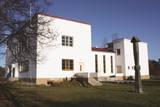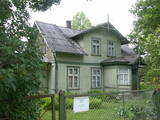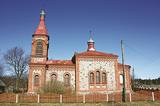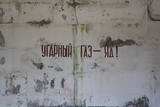| Nr | Nosaukums | Apraksts |
|---|---|---|
|
Atpūtas komplekss Rušonas ezera ziemeļrietumu krastā ar naktsmītnes, ēdināšanas un aktīvās atpūtas pakalpojumu piedāvājumu. |
||
|
Dobeles vārds vēstures avotos pirmo reizi minēts 1254. g. Dobele bija viena no visvairāk nocietinātajām zemgaļu vietām, tādēļ laikā no 1279. - 1289. g. pārdzīvoja sešus vācu krustnešu uzbrukumus. 1289. g. zemgaļi tomēr bija spiesti atkāpties. 1335. g. iekarotāji zemgaļu pils vietā uzsāka jaunas mūra pils celtniecību. Bērzes pretējā kreisajā krastā sāka veidoties tirgotāju un amatnieku miests. Pilsēta ļoti cieta Ziemeļu kara un tam sekojošā mēra laikā. Nozīmīgs notikums pilsētas saimnieciskajā dzīvē bija 1927. g., kad izbūvēja Liepājas-Glūdas dzelzceļa līniju. Pēc 2. pasaules kara Dobelē un tās apkaimē ieradās padomju militāristi, kas izbūvēja vienu no lielākajiem PSRS tanku poligoniem „Dobele-2". Tagad Dobeles apceļotājiem tiek piedāvāts interesants apmeklējamo objektu klāsts. |
||
|
Brīvdienu mājas "Korķi” apkārtnes priežu mežā ir izveidota Jāņtarpiņu taka. Ideāla vieta aktīviem sēnotājiem un ogotājiem. Savukārt saules un jūras cienītāji pa šo taku 5-10 minūšu gājienā nonāks Vitrupes pludmalē, kur varēs baudīt sauļošanās un peldēšanās priekus.
|
||
|
„Lācīši” meklējami Galgauskas pagastā, kas atrodas dienvidrietumos no Gulbenes. Saimniecības, kas ir viena no lielākajām Vidzemes ziemeļaustrumu daļā, specializācija ir graudaugi (577 ha), rapši (295 ha) un dažādu zālāju sēklaudzēšana. Otrs saimniecības darbības virziens ir piena lopkopība (ap 100 govis), gaļas lopkopība un jaunlopu audzēšana. Izveidota interesanta apspriežu – prezentāciju telpa, kas apvienota ar govju kūti (darbība kūtī vērojama cauri lieliem stikla logiem). Aktīvi iesaistās ES projektu apguvē. Iepriekš piesakoties, iespējama saimniecības apskate un pieredzes apmaiņa. |
||
|
Sākumā, lai iepazītos ar Latvijas amatniecību, apmeklējiet Latvijas Etnogrāfisko brīvdabas muzeju Rīgā, kur prasmīgi meistari parādīs jums latviešu tradicionālās prasmes. Izbraucot no Rīgas, apmeklējiet bērzu sulu un vīna darītavu. Izbaudiet Vikinga laivas braucienu pa Daugavu. Pēc tam dodieties uz saimniecību, kurā audzē kaņepes un izgatavo tradicionālo kaņepju sviestu. Tālāk - kazu saimniecība un mājas alus. Apciemojiet Latgales melnās keramikas darbnīcas, kā arī Ludzas amatnieku centru, kurā ir iespēja gūt ieskatu par vietējām tradīcijām. Tipiskā latgaļu saimniecībā ir iespēja izbaudīt tradicionālu pirts rituālu. Dodoties tālāk, apmeklējiet Aglonas baziliku, Aglonas maizes muzeju un saimniecību, kurā ražo garšīgu sieru un citus piena produktus. Pēc tam - Daugavpils vēsturiskais centrs, iespaidīgais 19. gadsimta cietoksnis un Skrošu fabrika. Atpakaļceļā uz Rīgu apskatiet iespaidīgo Rundāles pili. |
||
|
Neliela ziepju un dažādu citu ķermeņa kopšanas produktu darbnīca. Pašu audzētos un saimniecības pļavās ievāktos ārstniecības augus iestrādā ziepēs un skrubjos, gatavo no tiem izvilkumus augu eļļās, kurus iekļauj lūpu balzamos un krēmos. Ziepes tiek vārītas tā, kā to darīja agrāk - no sārma un taukvielām. Apmeklētājiem iespēja ielūkoties “Ezervanna” mazajā darbnīcā, paklausīties stāstā par ziepju vārīšanu, iemēģināt roku un radošumu skrubju gatavošanā vai “pamīcīties” ar ziepju veidojamo masu un pagatavot savu ziepju gabalu. |
||
|
Mazirbes centrā – baltais Lībiešu tautas nams, uzcelts 1939.g. «ar savas tēvzemes Latvijas un ar radu tautu - somu, igauņu un ungāru palīdzību». Līvu savienība namu atguva savā īpašumā 2000. gadā. Tas ir valsts nozīmes arhitektūras piemineklis. Katru gadu augusta pirmajā sestdienā kopā ar radu tautu pārstāvjiem te tiek svinēti vērienīgi Lībiešu svētki. Vasaras laikā te darbojas kafejnīca. |
||
|
Miervalža Ķemera muzejs – pazīstamajam
Latvijas kultūras darbiniekam (1902. – 1980.)
– mācītājam un gleznotājam veltīts
memoriālais muzejs Durbes ielā 21.
|
||
|
Centrālā un arī skaistākā Traķu iela, kas ved cauri Traķu pussalas ziemeļu daļai, ko kādreiz sauca arī par „Mazo pilsētu”. Ielas abās pusēs ir redzami visdažādāko krāsu koka namiņi. Te jāatceras, ka tipiskai karaīmu mājai uz ielas pusi ir vērsti trīs logi! Karaīmu ielas rietumu pusē (Karaīmu 30) atrodas viens no retajiem pasaules karaīmu lūgšanas dievnamiem – kenēze (kenesa) – vienstāva koka ēka ar zilganu jumtu. Savukārt, ēkā Karaīmu ielā 22 ir izveidota etnogrāfiska izstāde (Karaimų etnografine paroda). |
||
|
Ceļa malā, kas ved uz Kärdla pilsētu, ir zivju pārstrādes veikals, kur iespējams iegādāties Hījumā zvejnieku nozvejotas zivis gan svaigas, gan kūpinātas, kā arī tiek pārdoti Hījumā mazo ražotāju produkti. Zivis iespējams nobaudīt arī turpat uz vietas, veikalā ir kafejnīcas stūrītis, bet vasarā ārpusē ir terase.
|
||
|
Название Цесвайне в письменных источниках впервые упомянуто 1209 году. Для каждого путешественника Латвии город связан с родом барона Вульфа, который в 1815 году приобрел имение Цесвайне. Экономический расцвет Цесвайне наступил после строительства железной дороги Плявиняс - Гулбене. Город пострадал во время Второй мировой войны. В конце 2002 года в Цесвайнском дворце произошла трагедия - пожар, который затронул большую часть дворца. Благодаря большой поддержке общественности, государства и самоуправления Цесвайнский дворец обрел и по-прежнему сохраняет статус туристического объекта Видземского и Латвийского масштаба. |
||
|
Впервые в письменных источниках упомянута в 1387 году под названием Домеснес, и под этим именем известна до начала 20-го века. В церковной книге Ирбе - Гипки есть сведения, что в 1770 году в Колке было 4 двора - Кроги, Уши, Вецвагари и Кабрики. В 1844 году в Колке обустроили церковную школу, в которой учителем работал Ника Полманис, а первое здание школы в Колке было построено в 1881 году. Почти полвека учителем в ней проработал лив Карлис Бернштейнс (1881 - 1951). Предводителем Дундагского бунта, начавшегося в 1859 году, считается сын хозяина Колкских Сарнастов - ливонец Ника Шубергс (1833 - 1884). В конце 19-го века в Колке было 392 жителя, а в 1935 году из 343 жителей 145 были ливами. В середине 80-х годов 20-го века на ливском языке в Колке свободно говорили 13 ливов. Колка - единственная прибрежная ливская деревня, которая продолжала развиваться в условиях советского пограничного режима, поскольку она стала центром рыболовного колхоза. В 50-60-е годы население быстро росло, были построены новые дома, школа и народный дом, детский сад, рыбообрабатывающие заводы. Сейчас Колка с 700 жителями - самый большой поселок на побережье ливов. Здесь работает цех рыбообрабатывающей фабрики «Лицис-93», местные рыбаки и коптильщики рыбы, действует центр ливов «Kуолка» („Kūolka”) и ансамбль ливов «Лаула» (“Laula”), а в Ушах можно попробовать ливские блюда. |
||
|
Расположенов центральной части Екабпилса, ул. А. Пормаля, 11. Здание построено в 1931 году в стиле классицизма и до сегодняшних дней сохранило свой оригинальный банковский интерьер. Сейчас здесь разместился Екабпилсский филиал банка SEB. |
||
|
«Валдамо» (Vāldamō) - жилое здание желтого цвета и естественным кровельным материалом, построенное в начале прошлого столетия как новое хозяйство. «Вирго» - следующее (к северу) хозяйство за «Валдамо» (Vāldamō). Построено как новое хозяйство в двадцатых годах прошлого столетия. Жилой дом (1930 г.) отличается интересной резьбой по дереву. «Филмани» - следующее (к северу) за «Вирго». Постройка старинного вида возведена в начале ХХ века, как небольшая комната. Увидим «Силкални», если на перекрестке дороги повернем направо, в направлении Питрагса. Это здание желтого цвета, построенное примерно в 1906 г. как небольшая комната. «Норпиедаги» - находится на юге за «Силкални». Коричневого цвета и большего размера, чем предыдущее. Жилое здание примерно в 1906 году, как клеть небольшой комнаты строил активный ливский общественный работник и строитель лодок Дидрикис Волганский(1884 - 1968). 1912 г. здесь родился его сын Эдгарс Валгама, который также был работником ливской культуры и работал священником в Финляндии. «Андули» находятся около ранее упомянутого перекрестка дорог. Одно из крупнейших старых хозяйств поселка и старейший двор, история которого известна с 1680 года, когда он именовался «Кукини». Двор вмещал жилой дом(~ 1909 г.), ригу (1905 г.), клеть (середина XIX в.) и коптильню, построенную из перепиленной лодки. Под частью риги «Андули», которая построена на склоне дюны, находится средневековое, т.н. Чумовое кладбище. «Жоки» - напротив «Андулей» и с другой стороны дороги. Наблюдаемое сегодня здание построено на фундаменте исторического старого хозяйства. В середине XIX в. в «Жоки» находилась первая школа по чтению для ливских детей тогдашних прибрежных поселков Дундаги. Учителем работал лив Ника Полманис (1823 - 1903). «Тилмачи» - следующее (на севере) хозяйство за «Жоки». Сохранилось несколько зданий, которые строились на рубеже XIX – XX столетия: жилой дом коричневого цвета, конюшня и часть клети. Проводя реставрацию жилого здания, хозяин нашел доску с надписью «1825. Курляндская губерния». Упомянутые ранее семь исторических хозяйств и здания в свое время были кандидатами в список мирового культурного наследия ЮНЕСКО. |
||
|
Дивизион Сталдзенской зенитноракетной бригады занимал обширную территорию с масштабным с точки зрения количества и величины комплексом зданий. Часть из строений находится в частном ведении, обустроена коптильня для рыбы.
|
||
|
Одна из самых интересных особо охраняемых природных территорий Риги, предназначенных для защиты прибрежных биотопов – дюн, приморских береговых лугов и обитающих на них птиц и растений (здесь находится 29% видов орхидей). В этом природном заказнике была создана маркированная образовательная тропа со смотровой вышкой для наблюдения за птицами - единственная в Латвии смотровая вышка под открытым небом, приспособленная для людей в инвалидных колясках. |
||
|
Sarkanās klintis savu vārdu ieguvušas pateicoties sarkanajiem iežiem. Tieši sarkanā ir mīlestības krāsa, tāpēc sarkanās klintis ir romatiska pastaigas vieta mīlniekiem. Smilšakmens klintīs redzamas plaisas, kas sašķeļ sarkanīgos iežus, radot neparastu dabas mākslas darbu. To virsma ir diezgan izrobota, kas veido klintīs nelielas alas un nišas. Sarkanajās klintīs ir arī daudz dažādu avotiņu. Pazīstamākais no tiem ir Rūcamavots. Tam ir šāds nosaukums, jo tas, nākot ārā no zemes, izdod nelielu rūkoņu. |
||
|
Liellopu izsoļu nams ir vienīgais liellopu izsoļu nams Baltijā. Izsoles tiek rīkotas gaļas šķirņu jaunlopiem - buļļiem un telēm vecumā līdz 12 mēnešiem, regulāri - divas reizes mēnesī. Katru mēnesi izsolēs piedalās vairāk kā 2000 Latvijā audzēti jaunlopi. |
||
|
Находится в центре Вентспилса и расположено в построенном в стиле классицизма деревянном здании XIX столетия, которое принадлежало роду Купферов. Латышская кухня: Крестьянский завтрак, овсяная или манная каша, картофельные блины, тонкие блинчики с вареньем. Особое блюдо: Глазунья с окороком и маринованным огурцом. |
||
|
Atrodas Kūrmājas prospekta turpinājumā pie gājēju ietves, kas ved uz jūru. Piemineklis (uzstādīts 1977. g.) simbolizē sievieti, kas gaida mājās pārnākam savu vīrieti. |
||

























